Types of DC Motor
Following are the different types of dc motor:
- Series DC Motor
- Shunt DC Motor
- Compound DC Motor
- Separately excited DC motors
- Permanent Magnet DC Motor
Series DC Motor
The connection for a series-type DC motor is illustrated in Figure 1. A series-wound DC motor consists of a series field winding (identified by the symbols S1 and S2) connected in series with the armature (identified by the symbols A1 and A2).
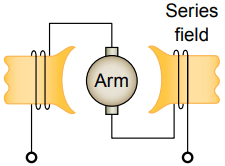
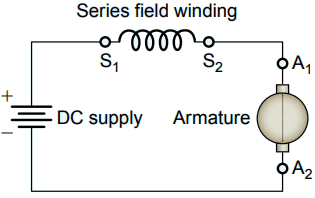
Since the series field winding is connected in series with the armature, it will carry the same amount of current that passes through the armature. For this reason the windings of the series field are made from heavy-gauge wire that is large enough to carry the full motor load current.
Because of the large diameter of the series winding, the winding will have only a few turns of wire and a very low resistance value.
A series-wound DC motor has a low resistance field and low resistance armature circuit. Because of this, when voltage is first applied to it, the current is high ( I = E/R ). The advantage of high current is that the magnetic fields inside the motor are strong, producing high torque (turning force), so it is ideal for starting very heavy mechanical loads.

Figure 2 shows the speed–torque characteristic curves for a series DC motor.
Note that the speed varies widely between no load and rated load. Therefore, these motors cannot be used where a constant speed is required with variable loads.
Also the motor runs fast with a light load (low current) and runs substantially slower as the motor load increases. Because of their ability to start very heavy loads series motors are often used in cranes, hoists, and elevators, which can draw thousands of amperes on starting.
Caution: The no-load speed of a series motor can increase to the point of damaging the motor. For this reason, it should never be operated without a load of some type coupled to it.
Shunt DC Motor
The connection for a shunt-type DC motor is illustrated in Figure 3. A shunt-wound DC motor consists of a shunt field (identified by the symbols F1 and F2) connected in parallel with the armature. This motor is called a shunt motor because the field is in parallel to, or “shunts,” the armature.
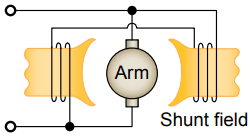
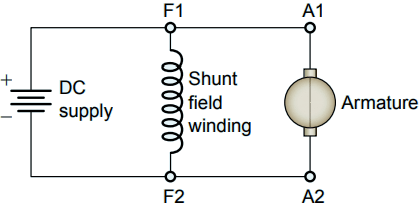
The shunt field winding is made up of many turns of small-gauge wire and has a much higher resistance and lower current flow compared to a series field winding.
Figure 4 shows the speed–torque characteristic curves for a shunt DC motor.
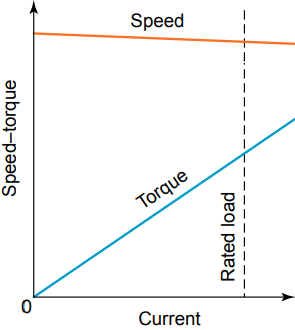
shunt DC motor.
Since the field winding is connected directly across the power supply, the current through the field is constant. The field current does not vary with motor speed, as in the series motor and, therefore, the torque of the shunt motor will vary only with the current through the armature.
When the motor is starting and speed is very low, the motor has very little torque. After the motor reaches full rpm, its torque is at its fullest potential. One of the main advantages of a shunt motor is its constant speed. It runs almost as fast fully loaded as it does with no load. Also, unlike the series motor, the shunt motor will not accelerate to a high speed when no load is coupled to it.
Shunt motors are particularly suitable for applications such as conveyors where constant speed is desired and high starting torque is not needed.
The field winding of a shunt motor can be separately excited or connected to the same voltage source as the armature. An advantage to separately exciting the shunt field is that a variable-speed DC drive can be used to provide independent control of the field and armature.
Compound DC Motor
A compound-wound DC motor is a combination of the shunt-wound and series-wound types. This type of DC motor has two field windings, as shown in Figure 5. One is a shunt field connected in parallel with the armature; the other is a series field that is connected in series with the armature.
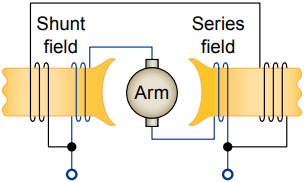

The shunt field gives this type of motor the constant-speed advantage of a regular shunt motor. The series field gives it the advantage of being able to develop a large torque when the motor is started under a heavy load.
This motor is normally connected cumulative-compound so that under load the series field flux and shunt field act in the same direction to strengthen the total field flux.
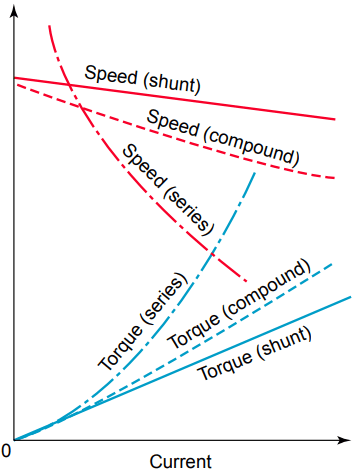
Figure 6 shows a comparison of speed–torque characteristic curves for a cumulative compound DC motor versus series and shunt types. The speed of the compound motor varies a little more than that of shunt motors, but not as much as that of series motors.
Also, compound type DC motors have a fairly large starting torque—much more than shunt motors, but less than series motors.
The shunt winding can be wired as a cumulative long-shunt or as a short-shunt compound motor. For short-shunt, the shunt field is connected in parallel with only the armature, whereas with long-shunt the shunt field is connected in parallel with both the series field and the armature.
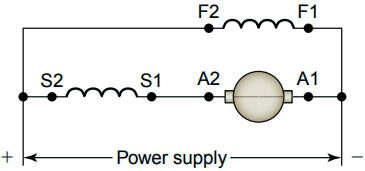
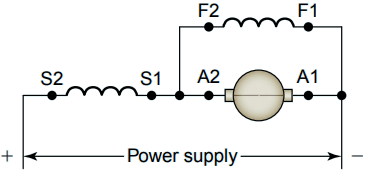
There is very little difference in the operating characteristics of long-shunt and short-shunt compound motors.
These motors are generally used where severe starting conditions are met and constant speed is required at the same time.
Separately Excited DC Motor
In these motors, the armature and field coils are fed from different supply sources. Very accurate speed control can be obtained by these motors. Moreover, these motors are best suited for the applications where speed variation is required from very low value to high value.
Permanent Magnet DC Motor
In these motors, the magnetic field is produced by small magnets. These motors are made in very small sizes and ratings. These motors are used where very small driving torque is required like toys.
Direction of Rotation
The direction of rotation of a wound DC motor depends on the direction of the field and the direction of the current flow through the armature. If either the direction of the field current or the direction of the current flow through the armature of a wound DC motor is reversed, the rotation of the motor will reverse.
If both of these two factors are reversed at the same time, however, the motor will continue rotating in the same direction.
For a series-wound DC motor, changing the polarity of either the armature or series field winding changes the direction of rotation.
If you simply changed the polarity of the applied voltage, you would be changing the polarity of both series field and armature windings and the motor’s rotation would remain the same.
Thanks for reading about “types of dc motor.”